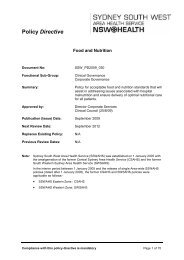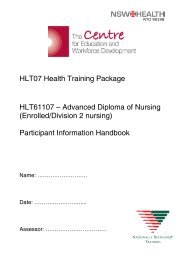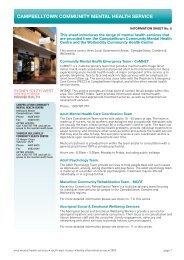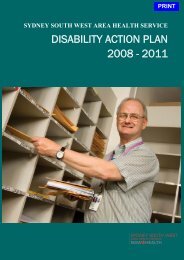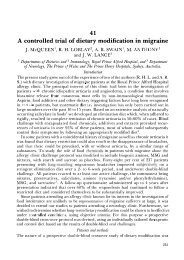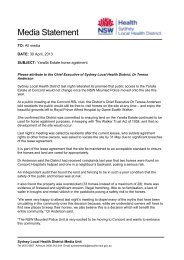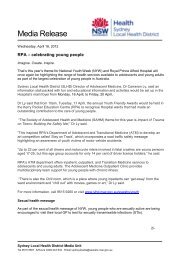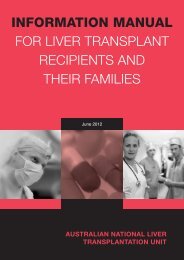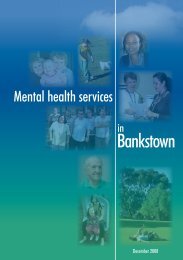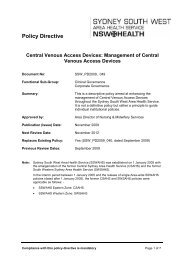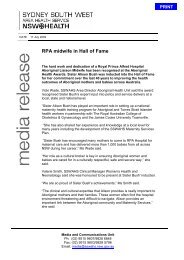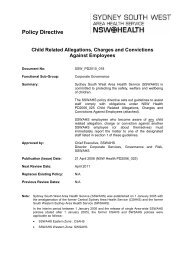Aged Care & Rehabilitation Clinical Services Plan 2007 – 2012
Aged Care & Rehabilitation Clinical Services Plan 2007 – 2012
Aged Care & Rehabilitation Clinical Services Plan 2007 – 2012
Create successful ePaper yourself
Turn your PDF publications into a flip-book with our unique Google optimized e-Paper software.
<strong>Aged</strong> <strong>Care</strong> & <strong>Rehabilitation</strong> <strong>Clinical</strong> Service <strong>Plan</strong> <strong>2007</strong> - <strong>2012</strong>New service models associated with psychogeriatric care are also being developed betweenSSWAHS and Holy Spirit Croydon in the Inner West, and Hammond <strong>Care</strong> at Hammondville.Various models have been proposed to undertake this work and are described further in theSSWAHS Sustainable Access <strong>Plan</strong> 2005. The Older Persons and <strong>Aged</strong> <strong>Care</strong> <strong>Services</strong> <strong>Clinical</strong>Redesign Project also addresses this issue. Without significant investment, the impact of improvedrelationships and systems between SSWAHS and RACFs will not be sufficient to address thedemands from population growth.8.12.1 State Government Residential <strong>Aged</strong> <strong>Care</strong> FacilitiesSSWAHS operates two state government residential aged care facilities (SGRACF) on behalf ofNSW Health. A review of all NSW SGRACFs has been undertaken, primarily to determine how thefacilities will meet new legislative requirements by the end of 2008. Results of the review are not yetavailable; however preliminary findings indicate that SSWAHS will be required to undertake planningto determine the future of these services.Queen Victoria Memorial HospitalQueen Victoria Memorial Hospital (QVMH) is a state-government operated residential aged carefacility. It holds 100 bed licences, 70 in high care and 30 in low care, although only 84 beds arecurrently operational. A number of options for the future of QVMH were raised through the reviewprocess, some of which may support SSWAHS with the management of complex patients. <strong>Plan</strong>ningfor QVMH is not within the scope of this <strong>Plan</strong>.Carrington Centennial Nursing HomeCarrington Centennial Nursing Home (CCNH) is a Third Schedule facility operated by CarringtonCentennial <strong>Care</strong> Ltd. Carrington Centennial <strong>Care</strong> is licensed to provide 94 high care beds on behalfof NSW Health. These high care beds complement 144 low care beds and community services alsodelivered from the site. Again, there have been a number of options for the future of CCNH raisedthrough the review process, some of which may support SSWAHS with the management of complexpatients. <strong>Plan</strong>ning for CCNH is not within the scope of this <strong>Plan</strong>.Recommendation – Residential <strong>Care</strong>/Residential Level <strong>Care</strong>Expand the range of services and supports offered in partnership with Residential <strong>Aged</strong> <strong>Care</strong>Facilities, to improve early intervention and reduce avoidable hospital admissions8.13 Community <strong>Care</strong> ProvidersAlong with community care services provided by SSWAHS, an extensive range of community careservices are provided by other government agencies and the non-government sector. Examplesinclude respite services, centre based day care, community options, transport and food services.The Commonwealth <strong>Care</strong>r Respite Centre (CCRC) and Commonwealth <strong>Care</strong>link program areauspiced by the non-government sector across SSWAHS. These programs coordinate respite careon a planned and emergency basis and provide information and referral advice with regard toservices for frail older people, people with a disability and their carers.Consistent with the high demand for services delivered by SSWAHS, there are long waiting lists toaccess many community care services. Lack of availability of community care services (particularlyhome modifications services) can delay patient discharge. A lack of community based casemanagement services can also result in unnecessary readmissions to hospital and/or residentialcare placement, in situations where a client is unable to manage their multiple care needs.Strong linkages exist between SSWAHS and many community based services, however these mustbe strengthened to ensure a quality continuum of care for the target group.Recommendation – Community <strong>Care</strong> ProvidersExpand the range of services and supports offered in partnership with community careproviders, to improve early intervention and reduce avoidable hospital admissionsPage 70




